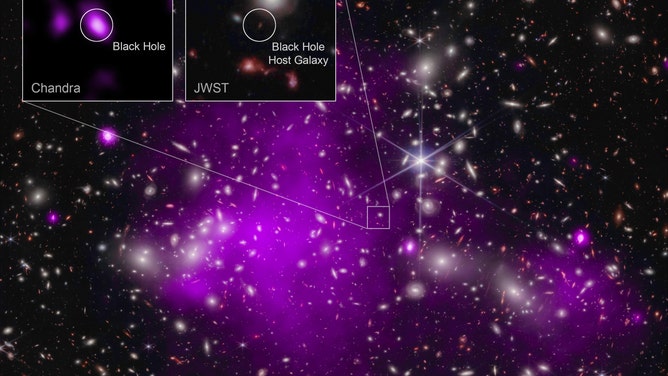Watch an intermediate-mass black hole take a bite of a wayward star and then fling the leftovers across the galaxy.
Using not one, but two powerful NASA space telescopes, astronomers have discovered a black hole so distant it could reveal how some of the first supermassive black holes formed.
Researchers combined data from NASA’s Chandra X-ray Observatory and the James Webb Space Telescope to seek out the signs of a growing black hole from 470 million years after the Big Bang – when the universe was only 3% of its current age, according to NASA.
The research using NASA telescopes led by Ákos Bogdán with the Harvard & Smithsonian Center for Astrophysics was published in Nature Astronomy on Monday.

These images show the galaxy cluster Abell 2744 that UHZ1 is located behind, in X-rays from Chandra and infrared data from Webb, as well as close-ups of the black hole host galaxy UHZ1. (Image Credit: X-ray: NASA/CXC/SAO/Ákos Bogdán; Infrared: NASA/ESA/CSA/STScI; Image Processing: NASA/CXC/SAO/L. Frattare & K. Arcand)
(NASA)
The black hole was found in galaxy UHZ1. NASA said it was hard to spot because it hid among a galaxy cluster about 3.5 billion light-years from Earth. However, Webb’s data revealed the young black hole in UHZ1 was much further, at 13.2 billion light-years from Earth.
SUPERMASSIVE BLACK HOLES: JUST HOW BIG ARE THEY?
The astronomy research team followed up on the Webb data with Chandra to find X-ray-emitting superheated gas. Astronomers say this is a trademark for a developing supermassive black hole.
Mystery surrounds how black holes form and grow so quickly
The discovery is exciting for black hole research because there is still much unknown about these enigmas of the universe. Astronomers believe black holes formed within the first billion years after the Big Bang.
Most, if not all, galaxies have a supermassive black hole at the center, but how they begin forming and reach colossal masses so soon after the Big Bang is still unknown.
“There are physical limits on how quickly black holes can grow once they’ve formed, but ones that are born more massive have a head start. It’s like planting a sapling, which takes less time to grow into a full-size tree than if you started with only a seed,” said study co-author Andy Goulding of Princeton University.
Astronomers use our Sun’s mass as a measurement for black holes. The mass of a black hole is usually called a “solar mass.” One solar mass is defined as the mass of our Sun.

This artist concept illustrates a supermassive black hole with millions to billions times the mass of our Sun. Supermassive black holes are enormously dense objects buried at the hearts of galaxies.
(JPL-Caltech / NASA)
Using Chandra and Webb data, the study authors say they have found strong evidence that this newly discovered black hole was born massive, estimated to be between 10 and 100 million Suns.
ARE BLACK HOLES A DANGER TO US?
This discovery lines up with a 2017 theory by Yale University astronomer Priyamvada Natarajan for an “Outsize Black Hole” that formed from the collapse of a massive cloud of gas.
“We think that this is the first detection of an ‘Outsize Black Hole’ and the best evidence yet obtained that some black holes form from massive clouds of gas,” Natarajan said in a statement. “For the first time, we are seeing a brief stage where a supermassive black hole weighs about as much as the stars in its galaxy, before it falls behind.”
This won’t be the last collaboration using JWST on black holes. The research team plans to use more data from Webb and other telescopes to investigate further the early universe, including Outsize Black Hole Galaxies.
